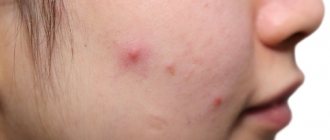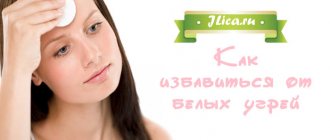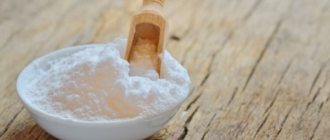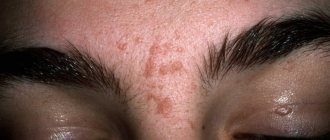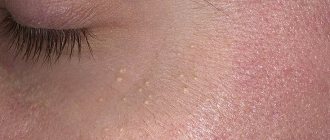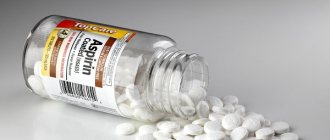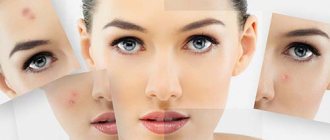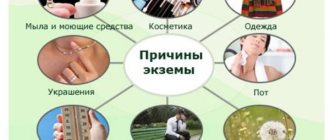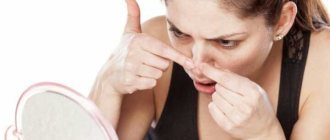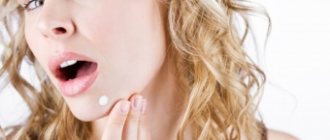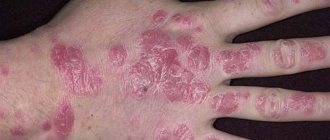Causes of cystic acne
The cause of the development of cystic acne is the overactive work of the sebaceous glands. The sebum they produce clogs the ducts and leads to the development of an inflammatory process against the background of the active proliferation of pathogenic bacteria. The following factors contribute to an increase in the production of sebaceous secretion by the glands:
- seborrheic dermatitis;
- hormonal changes;
- poor nutrition;
- alcohol abuse;
- taking hormonal drugs.
Seborrheic dermatitis is one of the main causes of severe acne. Dermatological pathology is accompanied by an increase in sebum secretion and a change in the quality of sebum. The pathological process is provoked by the yeast-like lipophilic fungi Pityrosporum ovale. In this case, cystic acne is a complication of seborrheic dermatitis, which requires separate therapy.
Hormonal changes are typical during puberty, pregnancy, as well as with pathologies associated with the adrenal glands and ovaries. Changes in the hormonal background lead to active work of the sebaceous glands. That is why cystic acne is most often observed during this period.
Frequent consumption of alcohol, sweet carbonated drinks, confectionery, chips, smoked foods, fried and fatty foods inevitably leads not only to intense sebum production, but also to a decrease in immunity. As a result, the skin becomes unable to independently fight the proliferation of pathogenic microorganisms, which cause severe acne.
Hormonal medications, which include oral contraceptives, insulin-based medications and inhibitors, also cause malfunction of the sebaceous glands and can lead to the development of dermatological diseases.
General information
Acne can have not only different locations (legs, arms, back, face, buttocks) but also appearance. In order not to confuse it with allergies or deprivation, it is better to look online at photos of what acne looks like. But making sure there is a problem does not mean solving it, and in this case, professional diagnostics are necessary, that is, laboratory tests.
The fact is that a dozen or even more factors can provoke the appearance of acne; they can only be established after checking the composition of the blood, a smear (in the localization area) and purulent discharge.
Clinical picture of cystic acne
The overactive work of the sebaceous glands, which results in the formation of a thick secretion, causes difficulty in outflow through the excretory ducts. Sebum accumulated in the ducts of the glands is a favorable environment for the development and reproduction of pathogenic microorganisms. The skin becomes infected, resulting in an inflammatory process. In severe acne, inflammation affects both the superficial and deep layers of the epidermis. As a result, such a pathological process leads to the appearance of fibrous scar formations.
The most common location for cystic acne is the skin of the face, chest and back. In the affected areas, there is enlargement of the pores, severe redness that extends beyond the sebaceous glands, as well as fibrous nodular growths. As the skin lesions mature, cysts form, which are subsequently filled with pus. The affected areas become dark red with a bluish tint. Fibrous purulent growths bring not only aesthetic discomfort, but also cause pain.
The formation of fibrous scar elements during the post-acne period occurs due to the replacement of the affected epidermal cells with dense connective tissue.
In the presented photos you can see a typical clinical picture characteristic of cystic acne.
Photos before and after
If a large number of inflamed pimples appear on the skin, you should contact a specialist. Otherwise, the infection may spread to neighboring areas.
Look, medicines for acne and pimples on the face. About the treatment of back acne in men with antibiotics. Find out further.
What are the causes and methods of treating acne on a woman’s back?
The answer is here. Inflamed acne causes a lot of trouble. Before treatment, it is necessary to find out the reason for their appearance, which will lead to a positive result in a short time.
Differential diagnosis of skin disease
In addition to examination by a dermatologist, the diagnosis of cystic acne includes the following measures:
- dermatoscopy;
- pH-metry;
- bacteriological culture.
Dermatoscopy is a hardware method of differential diagnosis, which can be used to conduct a visual assessment of pathological processes occurring in the dermis.
The acid-base balance is determined using pH meters in the form of glass electrodes. This diagnostic method allows you to differentiate the cystic form of acne from various forms of pyoderma, which are purulent-inflammatory skin diseases.
The material for bacteriological culture is the purulent contents of cysts and epidermal scales. The results of this analysis help to identify the type of bacteria and their resistance to certain antibiotics.
Drugs
Some medications, when used thoughtlessly, have side effects such as acne. Most often they appear after taking hormones, steroids and antibiotics.
This is why self-treatment of acne at home and using traditional methods is unsafe. There is a risk of scarring, the so-called post-acne, which looks no better than inflamed pimples.
Treatment methods for nodular cystic acne
Cystic acne includes the following therapeutic measures:
- taking antibiotics and retinoids;
- topical drugs;
- hardware method of treatment;
- nutrition correction.
Treatment of a dermatological disease begins with identifying and eliminating the cause of cystic acne. The duration of therapy can range from several months to a year or more, depending on the severity of acne.
Systemic antibiotics and retinoids
For severe acne, the following systemic antibiotics are prescribed:
- Minocycline;
- Minolexin;
- Doxycycline.
Drugs in this category are able to penetrate the fat barrier and accumulate in the area of inflamed areas. Potent antibiotics inhibit the growth of pathogenic bacteria and reduce inflammation. The duration of antibiotic therapy is from 1.5 to 2 months.
Taking antibiotics without a doctor's prescription is prohibited, as it can lead to deterioration of the condition of the skin if the drug is incorrectly selected and the treatment regimen is drawn up.
When nodular cystic acne does not respond to treatment with systemic antibiotics, the patient is prescribed retinoids. Drugs in this category are produced under the following pharmaceutical names:
- Roaccutane;
- Acnecutane;
- Will erase.
Treatment with retinoids lasts from 4 months to six months. As a rule, cystic acne completely disappears after the first course. In rare cases, a repeat course of treatment may be necessary.
The dosage of retinoids is selected by the doctor strictly individually, depending on the characteristics of the course of acne.
It is impossible to take drugs from this group without a prescription from a dermatologist, since retinoids can cause serious side effects, including hypervitaminosis, depression, headaches, impaired visual acuity, dyspeptic syndrome, anemia, etc. Also, medications against cystic acne have a large list of contraindications.
Local medications
In the treatment of nodular cystic acne, the most effective are topical preparations based on azelaic acid (Skinoren, Azix-Derm, Skinoklir), benzoyl peroxide (Eclaran, Baziron AC), retinol (Klenzit, Adapalene).
Preparations based on azelaic acid have an antiproliferative and antibacterial effect. They normalize disrupted keratinization processes in the ducts of the sebaceous glands and reduce the production of sebum.
Topical products containing benzoyl peroxide have a similar principle of action. These drugs restore damaged epidermal cells, saturate them with oxygen and reduce sebum production. The use of creams, ointments and gels of this group reduces the risk of fibrous scar elements during the post-acne period.
Local preparations from the group of retinoids have an anti-inflammatory effect and reduce the risk of acne cysts by reducing the thickness of sebaceous secretions. The first improvements in the condition of the skin are observed after 1-2 months with regular use of retinoids.
Physiotherapy
The most effective hardware methods of treatment are the following types of physiotherapy:
- laser therapy;
- phototherapy;
- Darsonvalization.
The above procedures help reduce inflammation, improve local blood circulation, increase the body's protective functions and enhance the effect of medications. Physiotherapy with an integrated approach to treatment leads to the resorption of infiltrates, which in turn avoids scarring.
Acne scars are treated with cryotherapy, cryomassage, laser peeling and mesotherapy. Such methods of therapy are used exclusively after eliminating the inflammatory process to eliminate scar formation.
Diet therapy
One of the ways to treat cystic acne is diet therapy. It is aimed at eliminating foods from the diet that lead to increased sebum production. During the treatment period, it is recommended to completely exclude or significantly reduce the consumption of the following products from the patient’s diet:
- semi-finished products;
- smoked meats;
- roast;
- fat;
- spicy;
- sweet;
- alcohol.
You should eat as much plant and protein foods as possible. Vegetables, fruits, berries, poultry, fish, beef, eggs, and dairy products help improve the condition of the skin and reduce inflammation.
The duration of diet therapy ranges from 1 month to six months or more.
How to deal with pimples and acne using topical products?
This can include a huge number of drugs: ointments, gels, masks, decoctions, chatterboxes, creams and even mini-plasters!
Proven drugs for the treatment of acne on the face:
- "Baziron AS" . Suitable for adults and teenagers; The main component of the product is benzoyl peroxide, the dosage of the substance may vary (the most “gentle” is 2%, the most “powerful” is 10%; there are also products with a 5% content of the substance). The drug is available in 2 main forms: ointment or gel. The French drug penetrates into the deep layers, “cleans” them, relieves inflammation, destroys infections and bacteria, helps the skin recover;
- "Skinoren" . An ointment that can be found in any pharmacy. The product is based on azelaic acid, a substance that “dries out” acne and skin. But be careful when using the drug: there is a risk of “drying” the skin;
- "Rozamet" . The ointment is white in color and has a pleasant aroma. The product is based on a powerful antibiotic - metronidazole (by the way, there are both gels and ointments with this name). "Rozamet" is considered one of the most effective drugs: acne goes away within 3-5 days after applying the ointment;
- "Metrogil" . This is a gel created on the basis of the same metronidazole. It has a slight cooling effect, soothes the skin, relieves redness and irritation, eliminates pain and blocks the active proliferation of bacteria;
- "Differin" . A cream that is used in combination with tablets and a special diet. The product acts not only on the surface, but also on the deeper layers, and has anti-inflammatory, disinfecting, and antimicrobial effects. The drug is considered one of the most effective, but its price can be intimidating;
- "Normoflorin-L" . This is not a medicine, but a dietary supplement with bifidobacteria. Based on this additive, homemade masks for acne, blackheads and pimples are made.
Folk remedies
Traditional medicine methods can be used in the treatment of cystic acne as an additional, but not primary treatment. To reduce inflammation, the following components of natural origin are used:
- aloe juice;
- chamomile decoction;
- calendula decoction.
The above remedies have a weak antiseptic effect, so they are not able to cure severe acne. They are used both for topical use and for oral administration.
Demodicosis
This is the name of the microscopic subcutaneous mite, which lives in every person in the layers of the epidermis. That is, everyone is a carrier of it, but it can provoke chronic acne if a person has a weak immune system or does not properly care for his own skin.
Mites settle in hair follicles, so the diagnosis of demodicosis is often accompanied by redness of the eyelids and the appearance of small red pimples in the area of the most abundant hair.
Relapse Prevention
Cyst-shaped acne not only requires a serious approach to treatment, but also requires prevention of relapses. The following measures will help prevent the development of cystic acne:
- thorough facial skin care;
- refusal of comedogenic cosmetics;
- weekly use of scrubs;
- use of antiseptic lotions;
- proper nutrition and giving up bad habits;
- timely treatment of internal pathologies;
- strengthening the immune system.
Before using this or that drug, do not forget to consult a specialist. A correctly designed treatment regimen and selected dosage of medications will reduce the risk of complications due to cystic acne and increase the effectiveness of therapy several times.Save
Preventive measures
It is possible to avoid the development of acne by following a number of recommendations.
- A proper and balanced diet, which includes fermented milk products and fresh vegetables and fruits;
- Avoiding excessively tight clothing and synthetic fabrics;
- Correct selection of cosmetics after visiting a specialist in the field of cosmetology;
- Prompt diagnosis and treatment of chronic diseases and aggravated ailments.
Types of treatment depending on the type of acne
Acne treatment is selected after preliminary determination of the type of inflammatory elements. Carried out under the supervision of a specialist.
Only - open and closed acne
Treatment is based on the use of retinoids, Azelaic acid or salicylic acid. To achieve the best result, additional medications may be prescribed.
Mixed form - acne and pimples
One of the following complexes is prescribed:
- retinoid and benzene peroxide;
- retinoid and antibiotic;
- retinode, benzene peroxide and antibiotic;
- azelaic acid and benzene peroxide;
- azelaic acid and antibiotic.
If the effect is mild, a retinoid and an oral antibiotic are additionally prescribed.
Only acne
Treatment is based on the use of a drug with benzene peroxide. If the effect is insufficient, other means are prescribed:
- antibiotic gel;
- a combination drug of benzoyl peroxide and antibiotic.
If the desired result is not achieved, an additional course of oral antibiotic is prescribed.
Cystic and nodular forms of acne
To treat such forms, oral antibiotics are used. Additionally, one of the complexes of drugs is used to combat mixed forms of acne.
If the result is weak, isotretinoin may be prescribed for internal use. But only in the absence of contraindications. If this remedy does not help, hormonal therapy is considered by an endocrinologist.
Four degrees
The degree is determined by the external signs of the disease. The number of comedones and various inflammatory elements is taken into account. There are 4 degrees in total:
- Easy. Up to 10 blackheads and comedones.
- Average. From 10 to 30 comedones and papules with purulent contents.
- Heavy. A large number of comedones, several dozen papules and a small number of pustules.
- Very heavy. The skin is affected by papules and pustules. There are more than 5 knots. I am worried about pain.
